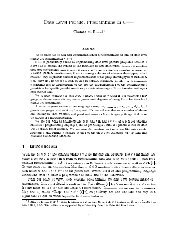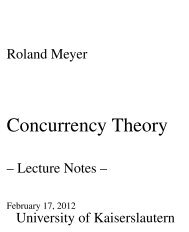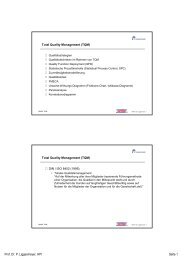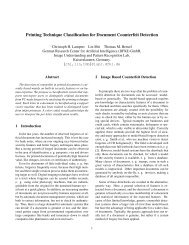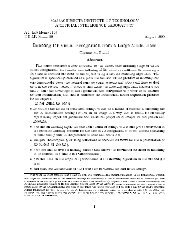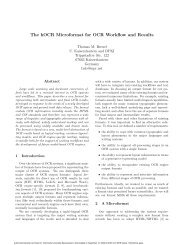Exercise Sheet 5 Problem 1: Lamport's Mutual Exclusion Algorithm ...
Exercise Sheet 5 Problem 1: Lamport's Mutual Exclusion Algorithm ...
Exercise Sheet 5 Problem 1: Lamport's Mutual Exclusion Algorithm ...
Create successful ePaper yourself
Turn your PDF publications into a flip-book with our unique Google optimized e-Paper software.
Concurrency Theory (WS 2011/12) Out: Tue, Nov 15 Due: Mon, Nov 21<strong>Exercise</strong> <strong>Sheet</strong> 5Jun.-Prof. Roland Meyer, Georgel CălinTechnische Universität Kaiserslautern<strong>Problem</strong> 1: Lamport’s <strong>Mutual</strong> <strong>Exclusion</strong> <strong>Algorithm</strong>Consider the Petri net below, describing Lamport’s 1-bit mutual exclusion algorithm.cs 1 idle 1req 1nid 1 id 1after you 2await 2id 2req2cs 2idle 2(a) set up the colinear property one would want the mutex to satisfy and determine theconnectivity and trap matrices of the given Petri net;(b) prove that the basic verification system is feasible;(c) prove that the enhanced verification system is infeasible.How do you interpret the fact that bvs is feasable and evs infeasible?The exercise is a bit of work but demonstrates the power of the analysis technique. The exampleis taken from J. Esparza, S. Melzer: Verification of Safety Properties Using Integer Programming:Beyond the State Equation. Formal Methods in System Design 16(2): 159-189 (2000).<strong>Problem</strong> 2: Conflict vs. Causality vs. ConcurrencyProve that for occurrence net (B, E, G) and distinct x, y ∈ B∪E, precisely one of the followingholds:• x and y are causally related (i.e. x < y or x > y)• x and y are in conflict (i.e. x ♯ y)• x and y are concurrent (i.e. x co y)
<strong>Problem</strong> 3: Configurations and Firing SequencesLet C = {e 1 , . . . , e n } be a configuration with normal event ordering: i < j if e i < e j . Prove thate 1 . . . e n is a possible firing sequence in the unfolding, producing the marking ({e ⊥ } • ∪ C • )\ • C.<strong>Problem</strong> 4: Unfoldings, Configurations, and CutsConsider the Petri net depicted below:(a) unfold the Petri net and outline one of its prefixes;(b) describe/list all the configurations and cuts of your unfolding.p 1 p 2t 1 t 2p 3t 3p 4 p 5t 4p 6 p 7Why is your unfolding finite?




